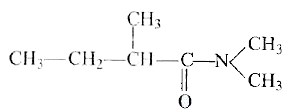Ph−NH2HNO2−−−→0∘CAHF−−→BF3BΔ−−→C, C is:
p- aminoazoxybenzene
m-aminoazobenzene
p-aminoazobenzene
All of these
The correct Answer is:C
To solve the question step by step, we need to analyze the reactions involved in the transformation of the compound starting from Ph-NH2 (aniline) to the final product C.
1. Identify the starting compound: The starting compound is aniline (Ph-NH2).
2. First Reaction with HNO2:
- Aniline reacts with nitrous acid (HNO2) at 0°C. This reaction leads to the formation of a diazonium salt.
- The reaction can be represented as:
Ph-NH2+HNO2→Ph-N+2(Diazonium salt)+H2O
- The product A is the diazonium salt (Ph-N2+).
3. Second Reaction with HF and BF3:
- The diazonium salt (A) is then treated with hydrofluoric acid (HF) in the presence of boron trifluoride (BF3). This reaction leads to the formation of fluorobenzene.
- The reaction can be represented as:
Ph-N+2+HF→Ph-F+N2+H+
- The product B is fluorobenzene (Ph-F).
4. Third Reaction with Heat (Δ):
- The fluorobenzene (B) is then subjected to heat. Under heating, fluorobenzene can undergo various reactions, but in this context, it typically leads to the formation of benzene (C) through elimination of HF.
- The reaction can be represented as:
Ph-FΔ−→C6H6+HF
- The final product C is benzene (C6H6).
Final Answer:
C is benzene (C6H6).
- Aniline reacts with nitrous acid (HNO2) at 0°C. This reaction leads to the formation of a diazonium salt.
- The reaction can be represented as:
Ph-NH2+HNO2→Ph-N+2(Diazonium salt)+H2O
- The product A is the diazonium salt (Ph-N2+).
- The diazonium salt (A) is then treated with hydrofluoric acid (HF) in the presence of boron trifluoride (BF3). This reaction leads to the formation of fluorobenzene.
- The reaction can be represented as:
Ph-N+2+HF→Ph-F+N2+H+
- The product B is fluorobenzene (Ph-F).
- The fluorobenzene (B) is then subjected to heat. Under heating, fluorobenzene can undergo various reactions, but in this context, it typically leads to the formation of benzene (C) through elimination of HF.
- The reaction can be represented as:
Ph-FΔ−→C6H6+HF
- The final product C is benzene (C6H6).
C is benzene (C6H6).
Topper's Solved these Questions
- AMINESBOOK - VMC MODULES ENGLISHCHAPTER - AMINESEXERCISE - ENABLE
45 Videos
- AMINESBOOK - VMC MODULES ENGLISHCHAPTER - AMINESEXERCISE - EFFICIENT
49 Videos
- ALDEHYDES,KETONES & CARBOXYLIC ACIDS BOOK - VMC MODULES ENGLISHCHAPTER - ALDEHYDES,KETONES & CARBOXYLIC ACIDS EXERCISE - IN-CHAPTER EXERCISE-M
10 Videos
- ATOMIC STRUCTUREBOOK - VMC MODULES ENGLISHCHAPTER - ATOMIC STRUCTUREEXERCISE - JEE Advanced (Archive )
67 Videos
Similar Questions
Knowledge Check
Identify A in the following sequence of reactions
ANH3−−→1 molBCHCI3−−−−→Alc.KOHCReduction−−−−−→(CH3)2CHNHCH3AEthyl halideBIso-propylamineCn-propyl halideDIso- propyl halideIdentify C in the following series C3H7IKOH−−→alc.ANas−−→ΔBKCN−−→alc.C
A(CH3)2CH−CNBCH2=CH−CH2CNCBr−CH=CH−CNDCH2=CH−C∣BrHCNH3C−CH2−CH3∣CH−C∣∣O−NH2Br2+KOH−−−−−−−−−→ΔA1.CH3I(excess)−−−−−−−−−−−−→2.AgOH,ΔB
The major product (B) is :ACH3−CH2−CH=CH2B CH3C−CH=CH−CH3D
CH3C−CH=CH−CH3D
Complete the following reactions:
(i) CH3−CH3∣C∣Cl−CH2CH3alcKOH−−−−→ΔAO3−−−−−→Zn/H2O(B+C)
(ii) CH3ICH−CH3alcKCN−−−−→A(i)SnCl2/HCl−−−−−−−−−−−−→(ii)H2O.OH.H2O2B
(iii) HCNHCl/AlCl3−−−−−−→A(i)C6H6Δ−−−−−−−−−−→(ii)(H2O)/H−B
(iv)
View SolutionThe product of the given reaction ,
CH3−∣CH3∣C∣OH−CH3∣C∣NH2−CH3HNO2−−−→ Product is :
View SolutionIdentify the major product in the following reactions :
C6H5−CH2−H∣C∣Br−CH3Alc.KOH−−−−−→Δ?HBr−−→ ?
View SolutionFind the last product [D] in reaction sequence
C6H5CHO+CH3−O∣∣C−CH2−COOC2H5 H3O+−−−→AΔ−−→CNH2−NH2−−−−−−→OH−/ΔD
View SolutionCH3CH2NH2(CH3CO)2O−−−−−−−→ΔA+B, (A) and (B) are
View Solution
